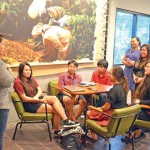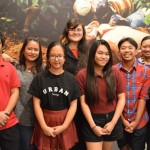MHS students to represent Pacific at RWDC
- Yvonne Pangelinan, the Public School System Commissioner for Student Support Services, shares a few words with the CNMI Aeronautics team, which would represent the Pacific at the 2017 Real World Challenge Competition championship. They are joined in this photo by Real World Challenge Competition CNMI coordinator and CNMI Aeronautics team coach Jeannifer Cubangbang and Marianas High School principal Cherlyn Cabrera.(Erwin Encinares)
- The CNMI Aeronautics team poses for a group photo with Associate Commissioner for Student Support Services Yvonne Pangelinan, second from left, Marianas High School principal Cherlyn Cabrera, second from right, and Real World Challenge Competition CNMI coordinator and CNMI Aeronautics team coach Jeannifer Cubangbang, far right. (Erwin Encinares)
A group of five Marianas High School students are off to represent the Pacific region in a nationwide contest after beating schools from all over the CNMI and Guam.
The five students, who call their group the CNMI Aeronautics, would be representing the Pacific in Washington, D.C., at the 2017 Real World Design Challenge Competition championship, or RWDC.
This is the sixth consecutive time the CNMI has represented the Pacific region in the RWDC championship.
The new group is a mix of MHS juniors and seniors: Ann Norcio, Daniel Villarmero, Ian Cataluna, Chenoa Bunts, and Melody Yang. They said they are a separate team from the MHS Aeronautical Dolphins, which has also won several RWDC nationals.
Norcio, the project manager and design engineer of the group, shared with Saipan Tribune that their RWDC project is focused on CNMI farmers.
“We made the project CNMI or indigenous. We looked first for the problems that the CNMI farmers are facing and crops grown in the CNMI. We also put the problem on a large scale. Crops here are not as large as those in the U.S., so we made it fit both scenarios,” explained Norcio.
The RWDC’s challenge for this year is to construct an unmanned aircraft, or a drone, that has multiple functions. Three missions were to be carried out by the drone, each with their own specific requirements.
The survey mission required the drone to stay in the air for at least 30 minutes, the logistics mission required the drone to be able to hold something weighing at least 8 lbs, and the dash mission required the drone to hold something that is at least 2 lbs and fly across a 1.5-mile field with the shortest amount of time possible.
The missions would be designed by the contestants, and are valid as long as the specific requirements for each mission are met.
“We had to choose two crops indigenous to Saipan. We chose taro, which we grow a lot here, and breadfruit [as payloads for the drone],” said Cataluna, who is the mathematician and mission planner for the group. “We are facing a world food crisis right now and the breadfruit is known for its carbohydrates. The breadfruit is known as the crop that would feed the world,” he added.
MHS principal Cherlyn Cabrera is understandably proud of the students.
“A lot of this is a combination of both hard work and teamwork and they were willing to do that. I am just so proud of them,” she said.
Jeaniffer Cubangbang CNMI RWDC coordinator and Aeronautics coach, shared the same sentiments and gave the students all the credit.
“We are just celebrating their success and [we] just want to share the awesome and tremendous success that they had. They are really just bright students and they are just very smart. I didn’t do anything, I just opened my classroom to them and listened to them; the glory goes all to them. They go to local establishments and try to get together to finish their submission to the competition.”
The group would be showcasing their winning design for the region this March at the 2017 CNMI islandwide STEM (Science, Technology, Engineering, and Math) Fair this March. The group is set to compete in the RWDC national championship representing the Pacific region in Washington, D.C. as a CNMI state team this April.





























